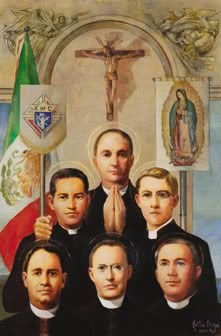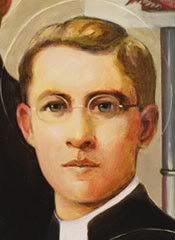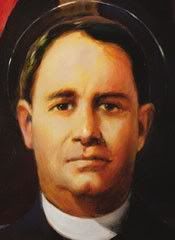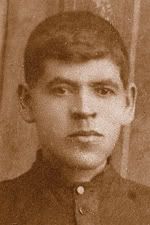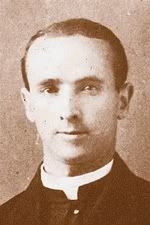I'm still trying to find out how freemasonry was behind all of this. I can see how Communism and Liberalism was behind it but there isn't really any concrete evidence to back up the claim of the freemasonry angle.
--------------------------------------------------------------------------------------------------------
Father Robert F. McNamara
St. Thomas the Apostle Roman Catholic Church
Rochester, New York
Laicism/Liberalism as instituted in Mexico by Freemasonry
The Catholic Church in Mexico has suffered greatly from persecution over the past 150 years. Mexico's government, under the influence of laicism, Freemasonry, political Liberalism, anticlericalism and Marxism, installed a constitution in 1917 that diabolically sought to eliminate Catholic religious education, repudiate religious vows and deny priests the right to vote; and, having declared all church property forfeit to the state, it forbade all religious rites outside the church buildings.
The pressure of the 1917 constitution naturally upset Catholics, but the successive presidents of the next two decades responded to their indignation with vigor, even to the point of bloodshed. Catholics understandably organized an armed Religious Defense League, called the “Cristeros”; but the existence of this activist group merely gave the government a further pretext to accuse all Catholics of treason, whether guilty or not.
President Plutarco Calles (1924-1928) became the Nero of the Mexican persecution. Many were executed during his regime, often after atrocious tortures. The government sought in particular to eliminate priests (simply admitting to being a priest was a capital offense), and members of the Catholic lay movement, Catholic Action. It also strove to replace the Catholic Church with a schismatic “Mexican Church.”
Warfare against the Church did not destroy it, but drove it underground. Spasmodic persecutions occurred under some of the successors of Calles. Only in the 1940's was the official policy of persecution halted. Great changes for the better have during subsequent decades. Pope John Paul II has visited Mexico and been warmly received; and Mexico has established diplomatic relations with the Holy See.
With peace reestablished between church and state, it has been possible to honor the martyrs of Mexico's hideous anti-Catholic war. This column has already told of the elevation to the rank of “blessed” in 1988, of the heroic Mexican Jesuit, Bl. Miguel Pro (1891-1927).
The moment before he was shot, Blessed Miguel cried out “Viva Cristo Rey!” (Long live Christ the King!) That had been the motto of the Mexican Catholics in the face of their persecutors. The implication was that it is better to obey God than men; that one should render to Caesar what is Caesar's, and to God what is God's. Pope Pius XI had established the feast of Christ the King in 1925 as a response to the tyrannies and totalitarianisms cropping up throughout the world. Mexico's Catholics, “always faithful,” had made that title their motto. Appropriately, Pope John Paul II chose the feast of Christ the King, Sunday, November 28, 1992, to beatify 26 more Mexicans.
One of these was a modern religious foundress, Bl. Maria de Jesus Venegas (1868-1959). The other 25 were victims of the persecutions of 1926-1929: 22 diocesan priests headed by Bl. Cristobal Magellanes; and three young laymen of Catholic Action who were closely associated with their parish priest and willing to die with him rather than deny their faith. Most of the 25 were killed by firing squads. The priest victims were from all over Mexico. The spirit of the lay martyrs is well expressed in the words of Manuel, the 28-year-old husband and father of three children: “I am about to die, but God will not die. He will take care of my wife and children.”
In his homily at St. Peter's, the Pope said that this rite of beatification was intended to be a reminder, in the fifth centennial of Columbus' discovery of America, of the gift that Mexican Catholics had made to the Faith. (It was pointed out that those chosen for beatification on this occasion were only a sampling of the large number of Mexicans who had given their lives for the Church.) Perhaps it was with the quincentennial celebration in view that Father Cristobal Magellanes had been designated the leader of the group. Cristobal is the Spanish form of Christopher Columbus' given name; and Magellanes reminds us of another early explorer for Spain, Ferdinand Magellan.
From their death the Holy Father drew a lesson greatly relevant to us: “We are all called to be witnesses to Jesus' sovereign, loving presence in the midst of mankind.”
Saint Thomas the Apostle Catholic Parish
Liberalism: Definition, Explanation, and Theological Ramifications
Catholic Encyclopedia
I suspect that Mexican Catholics will expose Freemasonry the same way that Poles continue to expose the horrors of Communism.
"I'm still trying to find out how freemasonry was behind all of this."
I've come to understand this as matter of simple obedience for the Church Militant. A Pope said, and I paraphrase, "Freemasonry is a no no." So, in obedience, we must avoid supporting and/or profiting from this organization. Freemasonry will never, on its own accord, reveal that it is in fact against all, in all or by slight reservation, that is Apostolic in obedience to the Teachings of Christ and to the Authority given to the Church to make God's kingdom come. So, we can stop holding our breath hoping that it's chief leader will shout, "Hell yes I ordered that code red!"
From the link you gave:
http://www.newadvent.org/cathen/09212a.htm
If you page down to near the end there's a document:
"On Freemasonry"; of 1 November, 1885
I googled the same.
ON FREEMASONRY; CUSTODI DI QUELLA FEDE; Encyclical of Pope Leo XIII promulgated on December 8, 1892.
http://www.papalencyclicals.net/Leo13/l13ms3.htm
To the Italian People.
Guardians of that faith to which the Christian nations owe their morality and civil redemption, We must dutifully discharge each one of Our supreme tasks. Therefore We must raise Our voice in loud protestations against the impious war which tries to take such a precious treasure away from you, beloved children. Already taught by long and sorrowful experience, you know well the terrible trials of this war, you who deplore it in your hearts as Catholics and as Italians. Can one be Italian in name and sentiment and not resent these continual offenses against divine beliefs? These beliefs are the most beautiful of our glories, for they gave to Italy its primacy over the other nations and to Rome the spiritual scepter of the world. They likewise made the wonderful edifice of Christian civilization rise over the ruins of paganism and barbarism.
Can we be Catholic in mind and heart and gaze with dry eyes on that land where our wondrous Redeemer deigned to establish the seat of His kingdom? Now We see His teachings attacked and His reverence outraged, His Church embattled and His Vicar opposed. So many souls redeemed by His blood are now lost, the choicest portion of His flock, a people faithful to Him for nineteen centuries. How can We bear to look upon His chosen people exposed to a constant and ever-present danger of apostasy, pushed toward error and vice, material miseries, and moral degradation?
2. This war is directed at the same time against the heavenly and the earthly kingdoms, against the faith of our ancestors and the culture which they handed on to us. It is thus doubly evil, being guilty of a divine offense no less than a human one. Is its chief source not that very masonic sect which We discussed at length in the encyclical "Humanum genus" of April 20, 1884, and in the more recent one of October 15, 1890, addressed to the bishops, the clergy and the Italian people? With these two letters We tore from the face of masonry the mask which it used to hide itself and We showed it in its crude deformity and dark fatal activity.
3. We shall restrict Ourselves now to its deplorable effects on Italy. For a long time now it has bored its way under the deceitful guise of a philanthropic society and redeemer of the Italian people. By way of conspiracies, corruptions, and violences, it has finally come to dominate Italy and even Rome. To what troubles, to what calamities has it opened the way in a little more than thirty years?
4. Our country has seen and suffered great evils in such a short span of time, for the faith of our fathers has been made a sign for persecutions of every sort. The satanic intent of the persecutors has been to substitute naturalism for Christianity, the worship of reason for the worship of faith, so-called independent morality for Catholic morality, and material progress for spiritual progress. To the holy maxims and laws of the Gospel, they have opposed laws and maxims which can be called the code of revolution. They have also opposed an atheistic doctrine and a vile realism to school, science, and the Christian arts. Having invaded the temple of the Lord, they have squandered the booty of the Church's goods, the greatest part of the inheritance necessary for the ministers, and reduced the number of priests by the conscription of clerics beyond the limits of extreme need. If the administration of the sacraments could not be impeded, they sought nonetheless to introduce and promote civil marriages and funerals. If they have not yet succeeded in seizing control of education and the direction of charitable institutions, they always aim with perseverance to laicize everything, which is to remove the mark of Christianity from it. If they could not silence the voice of the Catholic press, they made every effort to discredit and revile it.
5. In this battle against the Catholic religion, what partiality and contradictions there are! They closed monasteries and convents, but they let multiply at will masonic lodges and sectarian dens. They proclaimed the right of association, while the legal rights which all kinds of organizations use and abuse are denied to religious societies. They proclaim freedom of religion and reserve odious intolerance and vexations precisely for the religion of the Italians -- which, for that reason, should be assured respect and a special protection. They made protests and great promises for the protection of the dignity and independence of the pope, but you see their daily contempt of Our person. All kinds of public shows find an open field; yet this or that Catholic demonstration is either prohibited or disturbed. They encourage schisms, apostasies, and revolts against legitimate superiors in the Church. Religious vows and especially religious obedience are rebuked as contrary to human dignity and freedom, while impious associations which bind their followers by wicked oaths and demand blind, absolute obedience in crime are allowed to flourish with impunity.
6. We do not wish to exaggerate the masonic power by attributing to its direct and immediate action all the evils which presently preoccupy Us. However, you can clearly see its spirit in the facts which We have just recorded and in many others which We could recall. That spirit, which is the implacable enemy of Christ and of the Church, tries all ways, uses all arts, and prevails upon all means. It seizes from the Church its first-born daughter and seizes from Christ His favored nation, the seat of His Vicar on earth and the center of Catholic unity. To see the evil and efficacious influence of this spirit on our affairs, We have more than a few fleeting indications and the series of facts which have succeeded themselves for thirty years. Proud of its successes, the sect herself has spoken out and told us all its past accomplishments and future goals. It regards the public powers as its instruments, witting or not, which is to say that the impious sect boasts as one of its principal works the religious persecution which has troubled and is troubling our Italy. Though often executed by other hands, this persecution is inspired and promoted by masonry, in an immediate or mediate, direct or indirect manner, by flattery or threats, seduction or revolution.
7. The road is very short from religious to social ruin. The heart of man is no longer raised to heavenly hopes and loves; capable and needing the infinite, it throws itself insatiably on the goods of this earth. Inevitably there is a perpetual struggle of avid passions to enjoy, become rich, and rise. Then we encounter a large and inexhaustible source of grudges, discords, corruptions, and crimes. In our Italy there was no lack of moral and social disorders before the present events -- but what a sorrowful spectacle we see in our days! That loving respect which forms domestic harmony is substantially diminished; paternal authority is too often unrecognized by children and parents alike. Disagreements are frequent, divorce common. Civil discords and resentful anger between the various orders increase every day in the cities. New generations which grew up in a spirit of misunderstood freedom are unleashed in the cities, generations which do not respect anything from above or below. The cities teem with incitements to vice, precocious crimes, and public scandals. The state should be content with the high and noble office of recognizing, protecting, and helping divine and human rights in their harmonious universality. Now, however, the state believes itself almost a judge and disowns these rights or restricts them at will. Finally, the general social order is undermined at its foundations. Books and journals, schools and universities, clubs and theaters, monuments and political discourse, photographs and the fine arts, everything conspires to pervert minds and corrupt hearts. Meanwhile the oppressed and suffering people tremble and the anarchic sects arouse themselves. The working classes raise their heads and go to swell the ranks of socialism, communism, and anarchy. Characters exhaust themselves and many souls, no longer knowing how to suffer nobly nor how to redeem themselves manfully, take their lives with cowardly suicide.
8. Such are the fruits which the masonic sect has borne to us Italians. And after that it yearns to come before you, extolling its merits towards Italy. It likewise yearns to give Us and all those who, heeding Our words, remain faithful to Jesus Christ, the calumnious title of enemies of the state. The facts reveal the merits of this guilty sect toward our peninsula, "merits" which bear repeating. The facts say that masonic patriotism is no less than sectarian egotism which yearns to dominate everything, particularly the modern states which unite and concentrate everything in their hands. The facts say that in the plans of masonry, the names of political independence, equality, civilization, and progress aimed to facilitate the independence of man from God in our country. From them, license of error and vice and union of faction at the expense of other citizens have grown. The easy and delicious enjoyment of life by the world's fortunate is nurtured in the same source. A people redeemed by divine blood have thus returned to divisions, corruptions, and the shames of paganism.
9. That does not surprise Us. -- After nineteen centuries of Christian civilization, this sect tries to overthrow the Catholic Church and to cut off its divine sources. It absolutely denies the supernatural, repudiating every revelation and all the means of salvation which revelation shows us. Through its plans and works, it bases itself solely and entirely on such a weak and corrupt nature as ours. Such a sect cannot be anything other than the height of pride, greed, and sensuality. Now, pride oppresses, greed plunders, and sensuality corrupts. When these three concupiscences are brought to the extreme, the oppressions, greed, and seductive corruptions spread slowly. They take on boundless dimensions and become the oppression, plundering and source of corruption of an entire people.
10. Let Us then show you masonry as an enemy of God, Church, and country. Recognize it as such once and for all, and with all the weapons which reason, conscience, and faith put in your hands, defend yourselves from such a proud foe. Let no one be taken in by its attractive appearance or allured by its promises; do not be seduced by its enticements or frightened by its threats. Remember that Christianity and masonry are essentially irreconcilable, such that to join one is to divorce the other. You can no longer ignore such incompatibility between Catholic and mason, beloved children: you have been warned openly by Our predecessors, and We have loudly repeated the warning.
11. Those who, by some supreme misfortune, have given their name to one of these societies of perdition should know that they are strictly bound to separate themselves from it. Otherwise they must remain separated from Christian communion and lose their soul now and for eternity. Parents, teachers, godparents, and whoever has care of others should also know that a rigorous duty binds them to keep their wards from this guilty sect or to draw them from it if they have already entered.
12. In a matter of such importance and where the seduction is so easy in these times, it is urgent that the Christian watch himself from the beginning. He should fear the least danger, avoid every occasion, and take the greatest precautions. Use all the prudence of the serpent, while keeping in your heart the simplicity of the dove, according to the evangelical counsel. Fathers and mothers should be wary of inviting strangers into their homes or admitting them to domestic intimacy, at least insofar as their faith is not sufficiently known. They should try to first ascertain that an astute recruiter of the sect does not hide himself in the guise of a friend, teacher, doctor or other benefactor. Oh, in how many families has the wolf penetrated in sheep's clothing!
13. It is beautiful to see the varied groups which arise everywhere today in every order of social life: worker groups, groups of mutual aid and social security, organizations to promote science, arts, letters, and other similar things. When they are inspired by a good moral and religious spirit, these groups certainly prove to be useful and proper. But because the masonic poison has penetrated and continues to penetrate here also, especially here, any groups that remove themselves from religious influence should be generally suspect. They can easily be directed and more or less dominated by masons, becoming the sowingground and the apprenticeship of the sect in addition to providing assistance to it.
14. Women should not join philanthropic societies whose nature and purpose are not well-known without first seeking advice from wise and experienced people. That talkative philanthropy which is opposed to Christian charity with such pomp is often the passport for masonic business.
15. Everyone should avoid familiarity or friendship with anyone suspected of belonging to masonry or to affiliated groups. Know them by their fruits and avoid them. Every familiarity should be avoided, not only with those impious libertines who openly promote the character of the sect, but also with those who hide under the mask of universal tolerance, respect for all religions, and the craving to reconcile the maxims of the Gospel with those of the revolution. These men seek to reconcile Christ and Belial, the Church of God and the state without God
16. Every Christian should shun books and journals which distill the poison of impiety and which stir up the fire of unrestrained desires or sensual passions. Groups and reading clubs where the masonic spirit stalks its prey should be likewise shunned.
17. In addition, since we are dealing with a sect which has pervaded everything, it is not enough to remain on the defensive. We must courageously go out into the battlefield and confront it. That is what you will do, beloved children, opposing press to press, school to school, organization to organization, congress to congress, action to action.
18. Masonry has taken control of the public schools, leaving private schools, paternal schools, and those directed by zealous ecclesiastics and religious of both sexes to compete in the education of Christian youth. Christian parents especially should not entrust the education of their children to uncertain schools. Masonry has confiscated the inheritance of public charity; fill the void, then, with the treasure of private relief. It has placed pious works in the hands of its followers, so you should entrust those that depend on you to Catholic institutions. It opens and maintains houses of vice, leaving you to do what is possible to open and maintain shelters for honesty in danger. An anti-Christian press in religious and secular matters militates at its expense, so that your effort and money are required by the Catholic press. Masonry establishes societies of mutual help and credit unions for its partisans; you should do the same not only for your brothers but for all the indigent. This will show that true and sincere charity is the daughter of the One who makes the sun to rise and the rain to fall on the just man and sinner alike.
19. May this struggle between good and evil extend to everything, and may good prevail. Masonry holds frequent meetings to plan new ways to combat the Church, and you should hold them frequently to better agree on the means and order of defense. It multiplies its lodges, so that you should multiply Catholic clubs and parochial groups, promote charitable associations and prayer organizations, and maintain and increase the splendor of the temple of God. The sect, having nothing to fear, today shows its face to the light of day. You Italian Catholics should also make open profession of your faith and follow the example of your glorious ancestors who confessed their faith bravely before tyrants, torture, and death. What more? Does the sect try to enslave the Church and to put it at the feet of the state as a humble servant? You must then demand and claim for it the freedom and independence due it before the law. Does masonry seek to tear apart Catholic unity, sowing discord even in the clergy itself, arousing quarrels, fomenting strife, and inciting insubordination, revolt, and schism? By tightening the sacred bond of charity and obedience, you can thwart its plans, bring to naught its efforts, and disappoint its hopes. Be all of one heart and one mind, like the first Christians. Gathered around the See of Peter and united to your pastors, protect the supreme interests of Church and papacy, which are just as much the supreme interests of Italy and of all the Christian world. The Apostolic See has always been the inspirer and jealous guardian of Italian glory. Therefore, be Italians and Catholics, free and non-sectarian, faithful to the nation as well as to Christ and His visible Vicar. An anti-Christian and antipapal Italy would truly be opposed to the divine plan, and thus condemned to perish.
20. Beloved children, faith and state speak to you at this time through Us. Listen to their cry, arise together and fight manfully the battles of the Lord. May the number, boldness, and strength of the enemy not frighten you, because God is stronger than they; if God is for you, who can be against you?
21. Redouble your prayers so that God might be with you in a greater abundance of grace, fighting and triumphing with you. Accompany your prayers with the practice of the Christian virtues, especially charity toward the needy. Seek God's mercies with humility and perseverance, renewing every day the promises of your baptism.
22. As a pledge of these things and as a sign of Our paternal love, We bestow on you Our apostolic blessing, beloved children.
Given in Rome at Saint Peter's, the eighth day of December, 1892, in the fifteenth year of Our pontificate.
A NYC priest started the columbiettes as a result of witnessing many women exiting a meeting conducted by the communists.
I hope the K of C and Columbiettes might start events for singles for co-ed mingles and maybe get some wee little squire Colubi-mini's & lil' lady Columbi-mini-minettes :-)
Chivalry is gallant for the Natural Family as every man is noble by birth, king of his own castle, and the Faithful joyfully renders homage to the King of kings!
Long Live Christ the King!
I am working with a group at the local K of C to assist a Hispanic family of four whose father, a member, just died. >>
the very reason the K of C was formed so situations like this wouldn't happen.
